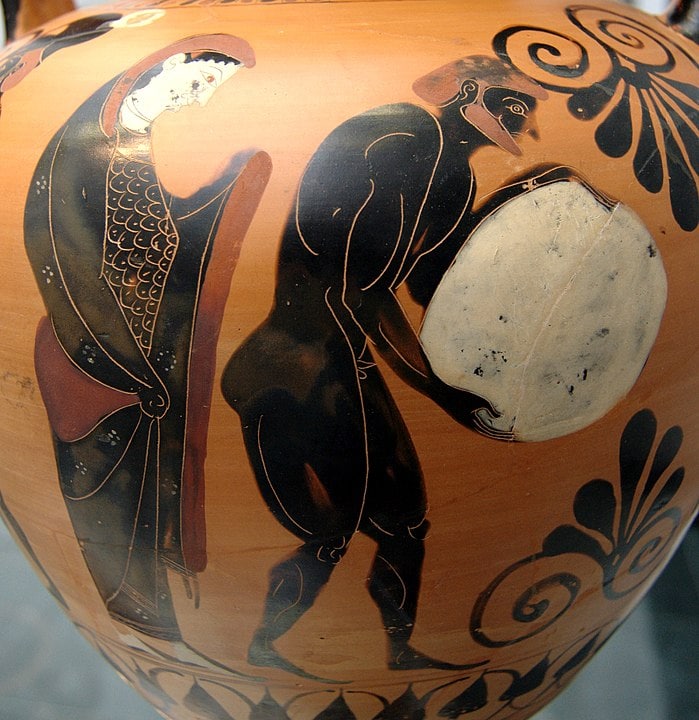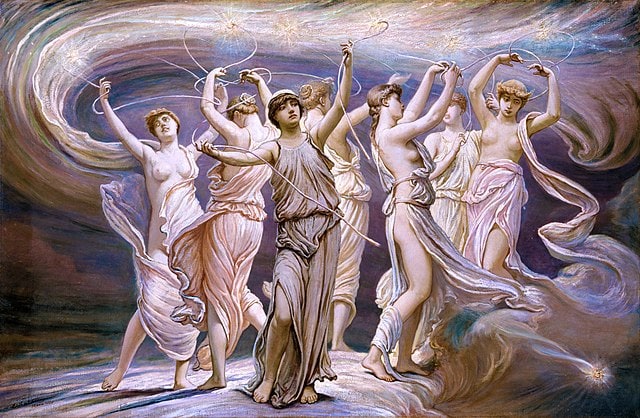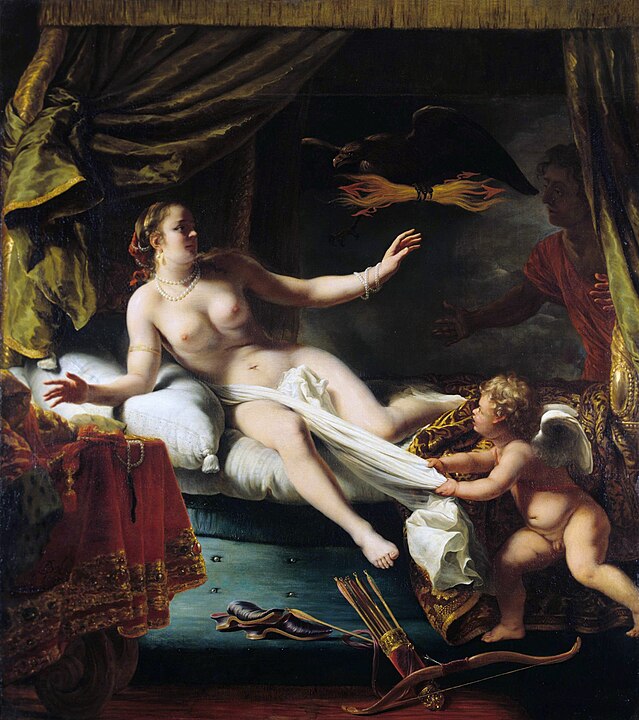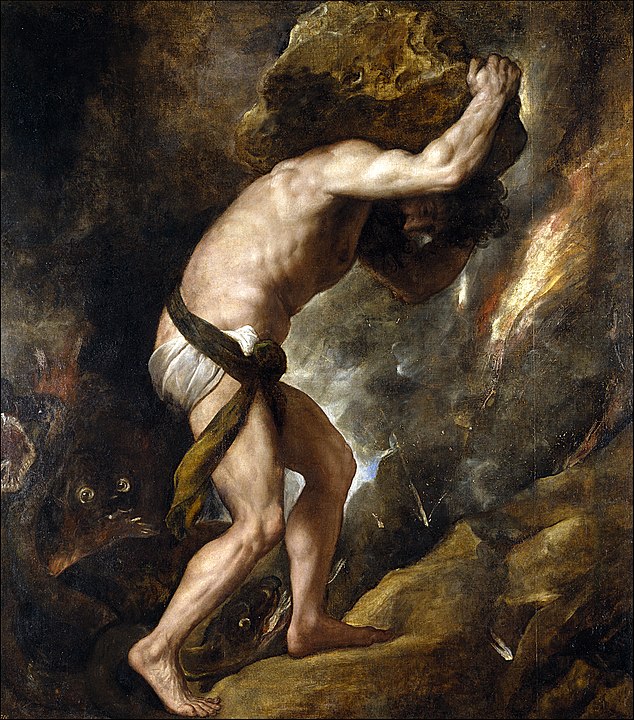
Table of Contents
In Greek mythology, Sisyphus (also spelled Sisyphos) was the King of Ephyra, supposedly the city of Corinth. He was famous for being a highly deceitful man for which he later received eternal punishment in the Underworld. Here’s his story.

Who Was Sisyphus?
Sisyphus was born to Enarete, the daughter of Deimachus, and Aeolus, the Thessalian king, who the Aeolian people were named after. He had several siblings, but one of the most prominent was Salmoneus, who became the king of Elis and founder of Salmone, a city in Pisatis.
According to certain ancient sources, Sisyphus was known as the father of Odysseus (the Greek hero who fought in the Trojan War), who was born after he seduced Anticleia. Both he and Odysseus had similar characteristics and were said to be very cunning men.
Sisyphus as King of Ephyra
When Sisyphus came of age, he left Thessaly and founded a new city which he named Ephyra, after the eponymous Oceanid who presided over the town’s water supply. Sisyphus became the king of the city after it was established and the city flourished under his rule. He was an intelligent man and established trade routes throughout all of Greece.
However, there was also a cruel and ruthless side of Sisyphus. He killed many guests at his palace and travelers, violating xenia, the ancient Greek rule of hospitality. This was in Zeus’ domain and he was angered by Sisyphus’ actions. The king took pleasure in such killings since he believe that they helped him to maintain his rule.
Wives and Children of Sisyphus
Various myths mention different wives associated with Sisyphus. In some accounts, Autolycus’ daughter Anticleia was one of his wives but she soon left him and married Laertes instead. She gave birth to Odysseus soon after she left Ephyra, so it’s likely that Odysseus was Sisyphus’s son and not Laertes’. Some say that Sisyphus didn’t actually marry Anticleia but only abducted her for a short period of time since he wanted to have his way with her in retribution for the theft of his cattle.
Sisyphus also seduced Tyro, his niece and the daughter of his brother Salmoneus. Sisyphus disliked his brother intensely and wanted to find a way to kill him without causing any problems for himself, so he consulted the Delphi Oracle. The Oracle prophesied that if Sisyphus had children with his niece, one of the children would one day kill his brother Salmoneus. Therefore, this was said to have been the reason for the marriage. Instead of killing his brother himself, Sisyphus was crafty enough to use his children to commit the murder.
However, Sisyphus’ plan failed. Tyro had two sons by Sisyphus but she soon found out about the prophecy and was worried for her father. In order to save him, she killed both her sons before they grew old enough to kill him.
Another woman associated with Sisyphus in myths is the beautiful Merope, one of the seven Pleiades and daughter of the Titan Atlas. She had four children by him including: Glaucus, Almus, Thersander and Oryntion. Oryntion later succeded Sisyphus as the king of Ephyra, but Glaucus became more famous as the father of Bellerophon, the hero who battled the Chimera.
According to the legend, Merope later felt ashamed for one of two things: marrying a mortal or her husband’s crimes. It’s said that this is why the Merope star was the dimmest one of the Pleiades.

Sisyphus and Autolycus
Sisyphus was the neighbor of the legendary thief and cattle rustler, Autolycus. Autolycus had the ability to alter the colors of things. He stole some of Sisyphus’ cattle and change their colors so that Sisyphus wouldn’t be able to identify them.
However, Sisyphus grew suspicious when he saw the size of his cattle herd reducing every day, while Autolycus’ herd continued to grow larger. He decided to cut a mark in the hooves of his cattle so that he could identify them.
The next time cattle disappeared from his herd, Sisyphus, with his army, followed their tracks in the mud to Autolycus’ herd and examined the hooves of the cattle there. Although the cattle looked different, he was able to identify them from the hoof marks and his suspicions were confirmed. In some accounts, Sisyphus slept with the daughter of Autolycus, Anticleia in revenge.
Sisyphus Betrays Zeus
Sisyphus’ crimes continued to grow in number, but soon he began to be noticed by Zeus, the god of the sky. He usually kept track of the gods’ activities and he soon discovered that Zeus had abducted Aegina, the naiad nymph and taken her to an island. When Aegina’s father Asopus came searching for his daughter, Sisyphus told him everything that had happened. Zeus found out about this soon enough. He wouldn’t tolerate any mortal interfering in his affairs so he decided to end Sisyphus’ life.

Sisyphus Cheats Death
Zeus dispatched Thanatos, the god of Death, to take Sisyphus down with him to the Underworld. Thanatos had some chains with him which he intended to use to bind Sisyphus but before he could do so, Sisyphus asked him how exactly the chains were to be worn.
Thanatos put the chains on himself to show Sisyphus how it was done, but Sisyphus quicly trapped him in the chains. Without releasing the god, Sisyphus went back to his palace as a free man.
By having Thanatos chained, problems began to arise in the world, because without him, no one died. This annoyed Ares, the god of war, since he saw no use of battle if no one died. Therefore, Ares came to Ephyra, released Thanatos and handed Sisyphus back to him.
In an alternate version of the story, it was Hades and not Thanatos who came to chain Sisyphus and take him to the underworld. Sisyphus tricked Hades in the same way and because the god was tied up, people who were old and sick couldn’t die but were instead suffering. The gods told Sisyphus that they would make his life on earth so miserable that he finally decided to release Hades.
Sisyphus Cheats Death Again
The time came for Sisyphus to die but before he did, he told his wife (possibly Merope) not to bury his body or undertake the funeral rites. He said the purpose of doing so was to test her love for him so Merope did as he asked.
Thanatos took Sisyphus into the Underworld and there in Hades’ palace, the King of Ephyra awaited judgement. While he was waiting, he went to Persephone, the wife of Hades, and told her that he had to be sent back to Ephyra so that he could tell his wife to give him a proper burial. Persephone agreed. However, once his body and soul were reunited, Sisyphus calmly went back to his palace without organizing his own funeral or returning to the Underworld.
Sisyphus’ Punishment
Sisyphus’ actions and impudence made Zeus even more angry. He sent his son, Hermes, to make sure that Sisyphus would return to the Underworld and stay there. Hermes was successful and Sisyphus was back again in the Underworld, but this time he was punished.
The punishment was for Sisyphus to roll an enormous boulder up a very steep hill. The boulder was incredibly heavy and it took him the entire day to roll it up. However, just as he reached the top, the boulder would roll back down to the bottom of the hill, so that he’d have to start again the next day. This was to be his punishment for eternity, as devised by Hades.

The punishment showed the ingenuity and cleverness of the gods and was designed to attack the hubris of Sisyphus. It forced the former king to be caught in a cycle of endless wasted efforts and frustration at never being able to complete the task.
Sisyphus’ Associations
The myth of Sisyphus was a popular subject for ancient Greek painters, who depicted the story on vases and black-figure amphoras, dating back to the 6th century BCE. One famous amphora is now placed in the British Museum with an image of Sisyphus’ punishment on it. It depicts Sisyphus pushing a huge boulder up a hill while Persephone, Hermes and Hades look on. In another, the former king is shown rolling a stone up a steep slope while a winged demon attacks him from behind.
Symbolism of Sisyphus – What We Can Learn From Him
Today, the word Sisyphean is used to describe futile efforts and a task that can never be completed. Sisyphus is often used as a symbol of humankind, and his punishment is a metaphor for our daily lives. Just like the punishment of Sisyphus, we too are engaged in meaningless and futile tasks as part of our existence.
However, the story can also be seen as a lesson to acknowledge and embrace our purpose, much like Sisyphus embraced his boulder-rolling. Even though the task may appear to be fruitless, we shouldn’t give up or back down but continue with our task. As Ralph Waldo Emerson said, “Life is a journey, not a destination”.
In Brief
Although Sisyphus was a highly clever man who committed many crimes and somehow managed to escape from justice each time, in the end, he had to pay for his actions. In an attempt to outsmart the gods, he doomed himself to eternal punishment. Today, he’s best remembered for how he tackled the task of his punishment and has become a symbol for humankind.








